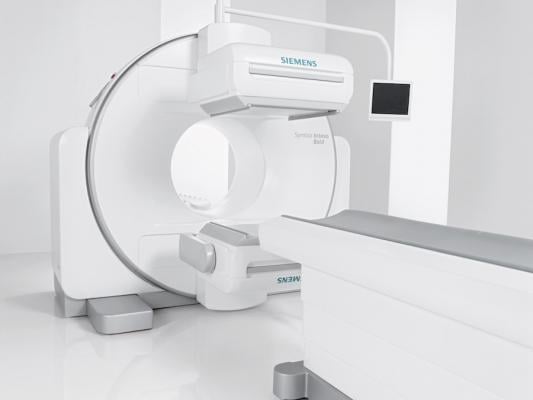
Siemens Healthineers debuts Symbia Intevo Bold at the 2017 annual meeting of the Society of Nuclear Medicine & Molecular Imaging (SNMMI). The system combines the company’s proven single-photon emission computed tomography (SPECT) technologies with new, high-performance CT capabilities to enable a wide range of clinical applications. These new CT options help make even challenging exams a matter of clinical routine. With products such as Symbia Intevo Bold, as well as a new name that underlines the company’s pioneering spirit and engineering expertise, Siemens Healthineers — the separately managed healthcare business of Siemens AG — helps healthcare providers worldwide meet current challenges and excel in their respective environments.
Symbia Intevo Bold addresses the growing trend of health care facilities using SPECT/CT systems in a dual-use setting, mirroring the rise of dual-use positron emission tomography (PET)/CT. More facilities are utilizing SPECT/CT systems as standalone or backup diagnostic CT systems. Additionally, institutions are looking to maximize efficiency for SPECT patients who also require a diagnostic CT scan by acquiring both sets of images on the same system. For these reasons, demand is increasing for SPECT/CT systems with optimal CT capabilities. Addressing that demand, the new Symbia Intevo Bold offers a host of optional applications that bolster the CT imaging capabilities of SPECT/CT.
“Symbia Intevo Bold advances the dual-use capabilities of SPECT/CT, enabling exceptional image quality in both forms of imaging at the lowest possible patient dose,” said Jim Williams, head of Siemens Healthineers Molecular Imaging.
Available on a Siemens Healthineers SPECT/CT system for the first time, the SAFIRE (Sinogram Affirmed Iterative Reconstruction) algorithm delivers excellent CT image quality while reducing patient radiation dose by as much as 60 percent. SAFIRE enables fast image reconstruction for easy implementation into a facility’s clinical routine. Additionally, SAFIRE reduces noise while maintaining detail visualization.
Also available for the first time on any of the company’s SPECT/CT systems, the iMAR (Iterative Metal Artifact Reduction) algorithm reduces metal-related artifacts caused by metallic materials, such orthopedic and dental implants. With this capability, customers can not only curb or eliminate artifact-induced distortion in CT images but also apply the CT images for attenuation correction to provide a more enhanced, accurate SPECT image.
The optional IVR (interleaved volume reconstruction) feature of Symbia Intevo Bold reconstructs overlapping CT images up to 32 slices to extract the maximum amount of diagnostic information from measured data, enabling evaluation of small structures such as lesions or fractures. IVR improves spatial resolution in the z-direction of all CT scans, regardless of pitch.
Finally, the single-source dual energy capability of Symbia Intevo Bold employs two sequential spiral CT scans operating at different kV levels to combine tissue information with disease morphology, improving image quality. Post-processing applications with the company’s syngo Dual Energy software include monoenergetic, Calculi Characterization, and gout.
In addition to these CT-optimizing features, the Symbia Intevo Bold SPECT/CT system offers established cutting-edge capabilities in SPECT imaging. For example, xSPECT Quant quantification technology enables automated, accurate, and reproducible quantification of not only Technetium-99m – the most common isotope in SPECT imaging – but also Iodine-123, Lutetium-177, and Indium-111. This capability extends the use of advanced SPECT quantification from general nuclear medicine and bone studies to indications including neurological disorders, neuroendocrine tumors, and prostate cancer.
For more information: www.usa.siemens.com/healthcare


 December 04, 2025
December 04, 2025 









